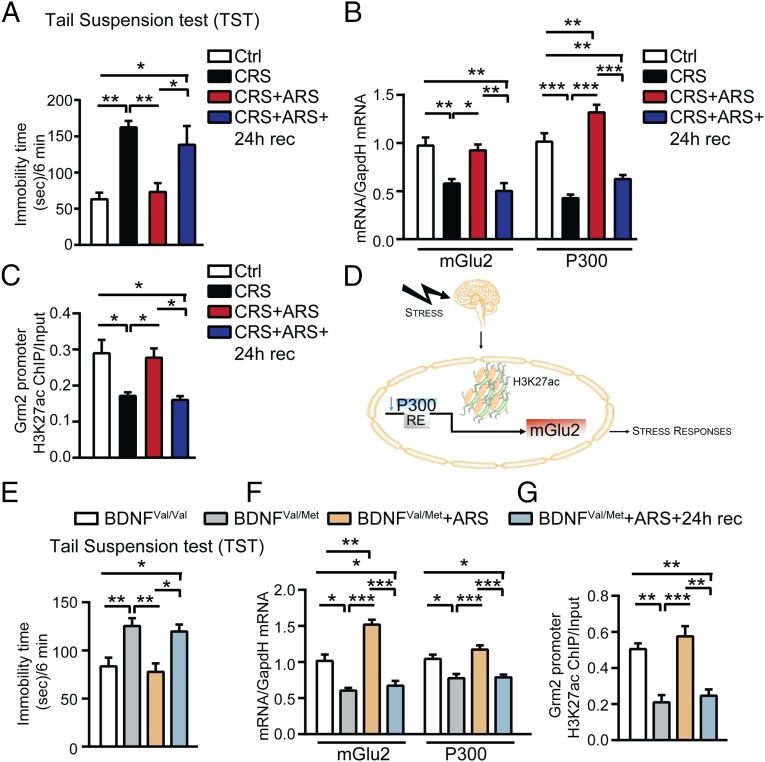Fig. 4.
P300 regulates the mGlu2-driven window of plasticity opened by stress in the hippocampus of CRS and BDNF Val66Met mice. (A) At 24 h after an additional ARS in CRS mice, immobility time at the TST was once again significantly increased (reappearance of depressive-like behavior) compared with age-matched controls, suggesting that the reversal effect observed 2 h after ARS in CRS mice was transient [TST, F3,16 = 9.65, P < 0.001 (stress)]. (B) Concomitantly, mGlu2 and P300 transcripts were once again down-regulated 24 h after ARS in CRS mice [mGlu2, F3,15 = 11.74, P < 0.001 (stress); P300, F3,19 = 32.01, P < 0.0001 (stress)]. (C) Chromatin immunoprecipitation assay (ChIP) showed that the CRS-induced decrease in the levels of acetylated H3K27 bound to the Grm2 promoter (which encodes for mGlu2 receptors) was rapidly reversed 2 h after ARS in CRS mice whereas levels of H3K27ac bound to the Grm2 promoter were once again down-regulated 24 h after ARS in CRS mice. (H3K27Ac, F3,20 = 6.54, P < 0.01 (stress)]. (D) P300 regulates acetylation of the lysine K27 on the histone H3 bound to the Grm2 promoter, which regulates expression of the mGlu2, to control stress responses. (E) A subset of susceptible heterozygous BDNF Met mice, identified at the light–dark test as anxiety-prone mice (Fig. S5), showed increased immobility time at the TST compared with age-matched male homozygous BDNF Val mice. The immobility time, in heterozygous BDNF Met mice, measured at the TST, was significantly reduced 2 h after ARS (i.e., less depressive-like behavior) whereas it was once again significantly increased 24 h after ARS (i.e., more depressive-like behavior) [TST, F3,36 = 7.22, P < 0.001 (stress)]. (F) The susceptible heterozygous BDNF Met mice showed reduced hippocampal mGlu2 and P300 levels compared with age-matched male homozygous BDNF Val mice. Two hours after ARS, mGlu2 and P300 levels were rapidly up-regulated in heterozygous BDNF Met mice whereas they were once again down-regulated 24 h after ARS [mGlu2, F3,13 = 36.29, P < 0.0001 (stress); P300, F3,14 = 13.2, P < 0.001 (stress)]. (G) ChIP showed that the susceptible heterozygous BDNF Met mice have reduced hippocampal levels of H3K27ac bound to the Grm2 promoter compared with age-matched male homozygous BDNF Val mice. At 2 h after ARS, levels of H3K27ac bound to the Grm2 promoter were rapidly up-regulated in heterozygous BDNF Met mice whereas they were once again down-regulated 24 h after ARS [H3K27Ac, F3,15 = 18.38, P < 0.0001 (stress)]. Bars represent mean + SEM, and * indicates significant comparisons with corresponding controls, *P < 0.05, **P < 0.01, ***P < 0.0001.

